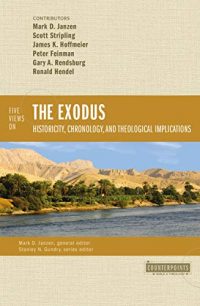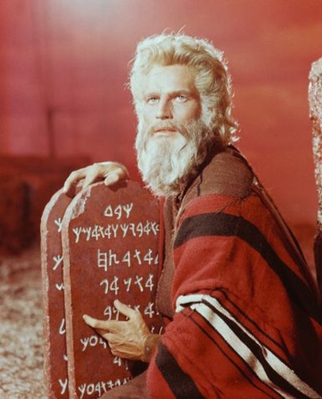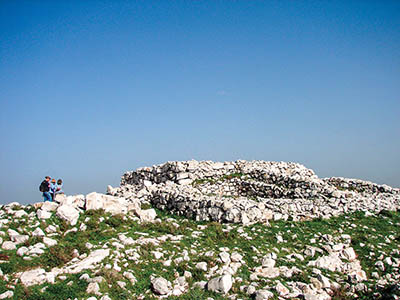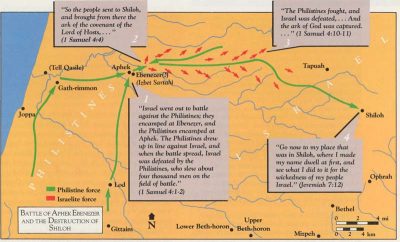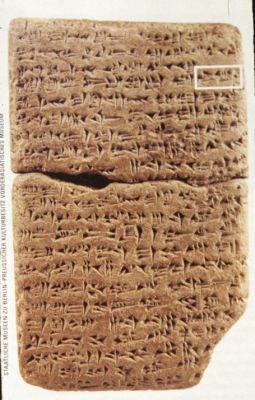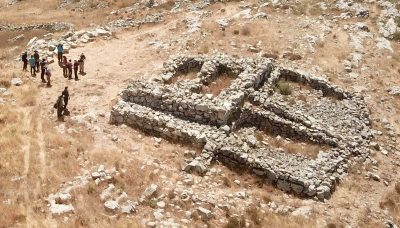
How do people process information? In particular, how to they handle cognitive dissonance? What happens when the data received is at variance with existing beliefs? Is it possible to escape a rut or paradigm especially if one has resided in it for decades or one’s entire academic life?
These thoughts occurred to as I was watching the unfolding story at the cultic site of Mar-a-Lago. It is a sacred place to which one goes to “kiss the ring” and be blessed” or from which disloyal people are cursed. As we are learning it is a place of secret texts. This discovery has led to a plethora of explanations both legal and for the mass media as to why such texts were at the cultic site.
The juxtaposition in my mind between the cultic site at Mar-a-Lago and the one at Mount Ebal occurred because of the serendipitous occurrence of the former being in the news every day while I was reading two articles in a memorial volume dedicated to archaeologist Adam Zertal:
“Mount Ebal Site in the Context of the History of Archaeological Research” by Zvi Gal, and
“The Mount Ebal Site in the Context of the History of Biblical Scholarship” by Sandra L. Richter and Ralph K. Hawkins.
As I was reading the articles, I could not help but think about how people respond when accepted values are threatened.
EBAL
The articles on Ebal responded to the reaction to the discovery of new evidence presented by Zertal. If his claims are true the object, an altar, has potentially significant implications for the understanding the history of early Israel prior to the monarchy.
Here are some of the criticisms Gal raised about biblical scholars’ reaction to the discovery of the purported altar at Mount Ebal which would have been used by Joshua.
1. While Tel Shiloh where the ark that the Philistines captured “has been referred to widely and regularly by scholars as a cult center,” Mount Ebal has been almost completely neglected despite its unique nature.
2. Negating the site or even worse ignoring it goes against both scientific and ethical criteria.
Gal’s article proceeds to analyze the two cultic sites of Shiloh and Ebal based on the archaeology and biblical texts. The crux of the issue refers to the absence of a temple or cultic place at Shiloh versus Zertal’s proposed altar that he claimed to have found at Mount Ebal.
Biblical scholars have no problem accepting that there had been an altar or temple at Shiloh – that acceptance poses no threat. However the same could not be said for an altar at Mount Ebal especially one dated to Iron I.
Response to Zertal, as we know was immediate. However, apparently the dominant postmodern trend in archaeology, which completely disregarded biblical archaeology, deterred scholars to the body of evidence in front of their eyes, and most responses were either laconic or were oral in nature, including even expressions of ridicule.
Overall, the responses by the scholars became more and more extreme. Instead of being an altar, it had to be something else. One alternative after another was suggested none of which would have been raised if the structure had been found at Shiloh.
The archaeological community continued to ignore the site and Zertal’s interpretation, until his death.
Hawkins and Richter echo these comments by saying:
Just as the Ebla site has been neglected by archaeologists, it has typically been sidestepped by biblical scholars as well.
Gal suggests the reasons for these actions are not academic in nature.
Indeed it seems that the almost overwhelming deterrent from dealing with the issue stemmed from the possible ramifications of understanding the biblical narrative. But again, the dominance of the postmodern trend in archeology was an impenetrable barrier for many scholars.
Gal posits that except for those implications, meaning taking the biblical account of Joshua’s actions seriously, the structure would be accepted as an altar. He notes the double standard taken by biblical scholars. He asserts that the current trend in archaeology is imbalanced. Gal comments that the interpretation of archaeological findings depends on the personality and views of the scholars. Contrary to the popular mantra about the truth setting you free, in some cases the truth undermines a lifetime of academic work. It is easy to overlook human psychology and to expect that people are light switches who easily can switch from one position to a diametrically different one simply by following the evidence.
To put the point more plainly, once people have made up their minds about something important, they are not going to change it. Once people are in a rut or a paradigm, the energy required to move them out of the rut or paradigm is insurmountable.
THE NAME GAME
The article by Hawkins and Richter addresses the issue of “name” in Deuteronomy. The word signifies a royal act of inscribing or installing a monument. Archaeologists depend on kings making their names great, that is building a monument of some kind to themselves that they, the archaeologists, will later uncover and install as trophies in their national museum.
The absence of such objects from Israel/Judah frequently has been noted. I do not address this question in my book The Exodus: An Egyptian Experience, but it is directly relevant to this topic. The departure from Egypt was not merely a physical action, it was a rejection of the Egyptian cultural construct as well. This means what I call the 11th Commandment applies:
Thou shalt not Ramses II.
Thou shalt not have a big ego.
Thou shalt not make thy own name great.
Therefore much to the dismay of archaeologists, Israel was created as a people prohibited from doing what was standard operating procedure elsewhere. They not only were aniconic for the deity but for the king.
Israel could, of course, make God’s name great. They could extol the praises of Yahweh. They could do so not only in poetry/song but at an altar with inscribed writing on plaster. When would they first do so?
Here it helps to think geopolitically and not simply theologically. Merneptah claimed to have destroyed the seed of Israel. Obviously he did not succeed. Who led Israel in battle against the Egyptians? At this point in time the only possible candidate is Joshua. That is hardly proof but would be considered a reasonable speculation if the Bible were not THE BIBLE.
Merneptah’s failure helped put Israel on the map, so to speak, within, the Canaanite political world. Egypt had failed twice against Israel. Yahweh was not merely a deity who led Israel out of Egypt, he was a deity who fought for Israel in the land of Canaan. The Book of Jashar (Josh. 10:12-13) and the Song of Deborah (Judges 5) both sing the praises of the warrior deity in Canaan. For there to be a physical place to make the name great of this warrior deity seems eminently reasonable.
A location near Shechem made sense for these hill-country people. Shechem had a history of anti-Egyptian activity. It was located at the navel of the universe. It may even have contributed chariots to the confrontation with Merneptah. The altar at Mount Ebal needs to be put into its geopolitical context following the Exodus from Egypt. Given the desire of a people to celebrate Pharaoh not having destroyed their seed, an altar at Ebal to make the name great of this warrior deity seems eminently reasonable.
ETERNAL LIFE AND THE COVENANT
There is more to the story than the mere construction of an altar. In my book, I touch upon a subject that can be ignored given that the Exodus did not occur. But since it did occur, it should be mentioned. Moses had to face two important realities in the wilderness. His dream of a Canaanite Spring and the liberation of the land of Canaan from Pharaonic rule would not be realized in his lifetime. If anything, beginning in Year 8 of Ramses following the Exodus, the situation in the land became even more oppressive.
First, Moses was going to die in the wilderness. He had been raised in a culture of eternal life based on the Osiris model. That approach was deeply woven into the Egyptian cultural construct as evident by the major infrastructure work at Abydos by Seti and Ramses. Obviously in the wilderness and given the rejection of the Egyptian cultural construct that option was not available to him. At least his burial mountain could be bigger.
Another option was the Gilgamesh one. Instead of seeking immortality of the body, it could be achieved through the walls of the city. However, again, in the wilderness such immortality was not an option. But it did show that eternal life was possible through something other than one’s physical body. How about through a covenant?
In my book I wrote:
I speculate that Moses rejected the popular Osiris cult and eternal life of the body through its mummification. Although Moses did not author
“I call heaven and earth to witness against you this day, that I have set before you life and death, blessing and curse; therefore choose life, that you and your descendants may live” (Deut. 30:19),
that sentiment reflected his values that he imprinted on the people Israel. Eternal life for the Israelite would not be as an individual but as a people expressed through the covenant. As long as individuals committed themselves to the covenant, the people Israel lived even if they were wandering in the wilderness. Immortality was not of the individual body but of the body of the people. I suspect this development was part of Plan B when the initial goal of going directly to Canaan was thwarted and the wandering in the wilderness commenced instead. Eventually, there came a time when Moses realized he needed to define the identity of the people in a way that would survive his death and that of the people who had left Egypt with him.
The covenant renewal ceremony at Mount Ebal following a victory over Egypt was a continuation of the Exodus. It expressed the vision of Moses that he imparted to the people he had created. It was an inspired solution to the real world dilemma Moses faced. Amihai Mazar repeatedly promotes the importance of human agency in understanding the life of David. That consideration should be extended back to Moses. But, of course, not only can the structure at Mount Ebal not be an altar, the Exodus can not have occurred either.


